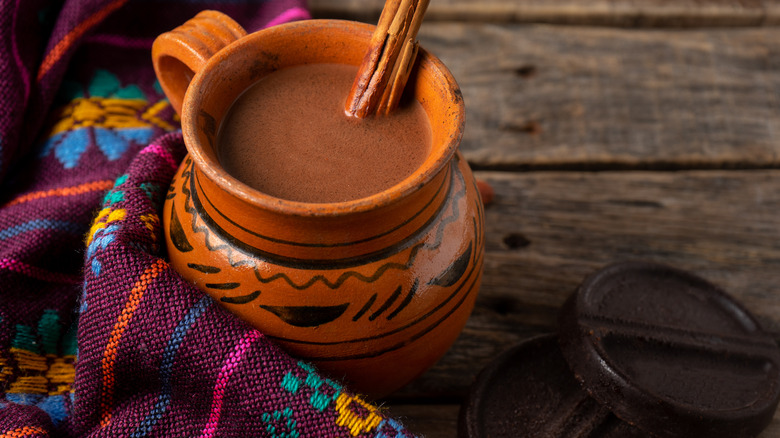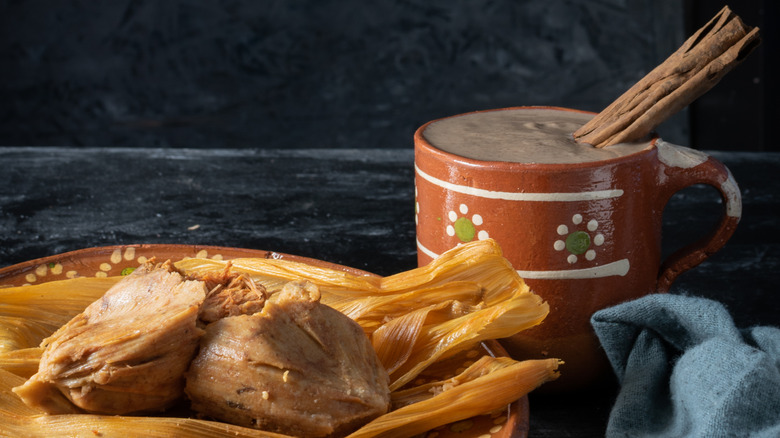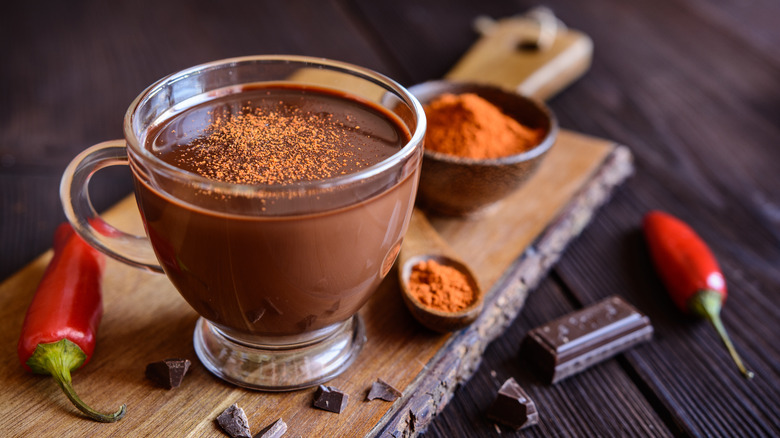The Most Common Sides Served With Mexican Hot Chocolate
Hot chocolate is a classic nostalgic beverage. Everything about it elicits a memory from the cup it is served in, the garnishes it's topped with, the ingredients used, and even the method in which it is made. But where did this cocoa creation come from, and how is it enjoyed today?
We share our love for hot chocolate with the Mayans and other Mesoamerican cultures. Over 5,000 years ago, this rich ingredient was consumed during festive rituals for its deity-like properties, per History.com. However, it was bitter and lukewarm, much different than how we enjoy hot chocolate today. Over time, it was sweetened and spread to other regions of the world, becoming an integral part of cultural celebrations everywhere.
Along with this chocolatey beverage came the art of drink dunking. According to the Loudoun Museum, this action can be tied to ancient Romans and their biscuit and wafer dunking practices. Here, they lightly soaked crisp and hardened foods to soften them before eating. Though this may have to do more with texture than taste, it did start a historical trend that evolved into sweet, salty, and spicy pairings.
Despite the global changes to the holiday drink, Mexican hot chocolate has remained in touch with its roots. But what exactly is this beverage, and what should you serve it with?
What to pair Mexican hot chocolate with
Compared to sweetened American hot chocolate, which usually comes in powdered packets and chocolate bombs, Mexican hot chocolate leans more on the richer-tasting and spicier side. It's created from a blend of unsweetened chocolate, cinnamon, and chili powder (via Food Network). Authentic Mexican cook, Isabel Orozco-Moore of Isabel Eats, shares that she enjoys her Mexican hot chocolate with a traditional Mexican sweetbread called marranito. The Busy Abuelita agrees, sharing that Mexican Gingerbread Pigs (marranitos) are the "perfect" pairing with Mexican coffee or hot chocolate.
Champurrado is a traditional Mexican cocoa beverage that aids in celebrating special holidays such as Dia de Los Muertos and Las Posadas. It is a thick chocolate-based atole made from Mexican chocolate, unrefined cane sugar, and cinnamon sticks (via Muy Delish). It also includes corn flour (or masa de maíz and masa harina), which helps separate it from the rest of Mexico's holiday classics. This important ingredient allows the drink to thicken into the creamy, sweet, and flavorful beverage many know it to be. It is best served with churros and tamales (per Dora's Table). Both sides can elevate the experience of sipping on warm champurrado with their crispy outside and soft, pillowy filling.
Mexican hot chocolate and champurrado is surprisingly easy to make
Apart from a few pastry additions, many cocoa beverages are often served with cinnamon sticks to enhance their rich flavor. Spices like chili powder and cayenne pepper can also be added to create depth in the melted layers of bittersweet cocoa. Food52 reports that this popular pairing is often used because of the pepper's ability to numb parts of the tongue. As a result, we may become more sensitive to hidden tastes or flavors that we may otherwise miss. However, if you aren't a fan of cinnamon or spice, you can substitute these for mini marshmallows and whipped cream to add the perfect frothy layer on top.
To make Mexican hot chocolate, Food Network suggests simmering a blend of milk, cinnamon, nutmeg, and some vanilla extract in a pan before adding Mexican chocolate and other seasonings, including cayenne pepper. Allow it to mix before serving it with a garnish of choice. You can even spike it with a splash of tequila or rum for a spiked hot chocolate.
Champurrado is also easy to make, but there are a few key differences. First, you must prepare your thickener, which consists of pre-selected corn flour and water, as directed by Muy Delish. Then, in a layering technique, add your water, cinnamon, and cane sugar before mixing in the milk and Mexican chocolate. Allow the champurrado to thicken before serving it with bolillo, churros, or tamales for an authentic experience.


